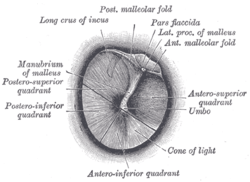
Otoscope - Image of an otoscope (center)

Anatomy of the human ear.

Right tympanic membrane as seen through a speculum.
An Otoscope or auriscope is a medical device which is used to look into the ears. Health care providers use otoscopes to screen for illness during regular check-ups and also to investigate when a symptom involves the ears. With an otoscope, it is possible to see the outer ear and middle ear.
Otoscopes consist of a handle and a head. The head contains a light source and a simple low-power magnifying lens, typically around 8 diopters. The distal (front) end of the otoscope has an attachment for disposable plastic ear specula. The examiner first straightens the ear canal by pulling on the pinna and then inserts the ear speculum side of the otoscope into the external ear. It is important to brace the hand holding the otoscope against the patient's head to avoid injury to the ear canal by placing the index finger or little finger against the head. The examiner can then look through a lens on the rear of the instrument and see inside the ear canal. In many models, the lens can be removed, which allows the examiner to insert instruments through the otoscope into the ear canal, such as for removing earwax (cerumen). Most models also have an insertion point for a bulb capable of pushing air through the speculum which is called pneumatic otoscope. This puff of air allows an examiner to test the mobility of the tympanic membrane.
Many otoscopes used in doctors offices are wall-mounted, while others are portable. Wall-mounted otoscopes are attached by a flexible power cord to a base, which serves to hold the otoscope when it's not in use and also serves as a source of electric power, being plugged into an electric outlet. Portable models are powered by batteries in the handle; these batteries are usually rechargeable and can be recharged from a base unit. Otoscopes are often sold with ophthalmoscopes as a diagnostic set.
Diseases which may be diagnosed by an otoscope include otitis media and otitis externa, infection of the middle and outer parts of the ear, respectively.
Otoscopes are also frequently used for examining patients' noses (avoiding the need for a separate nasal speculum) and (with the speculum removed) upper throats.
External links
|
|---|
| | | | Professions | |
|---|
| | Settings | |
|---|
| | Care | |
|---|
| | Skills / Training | |
|---|
| |
|


